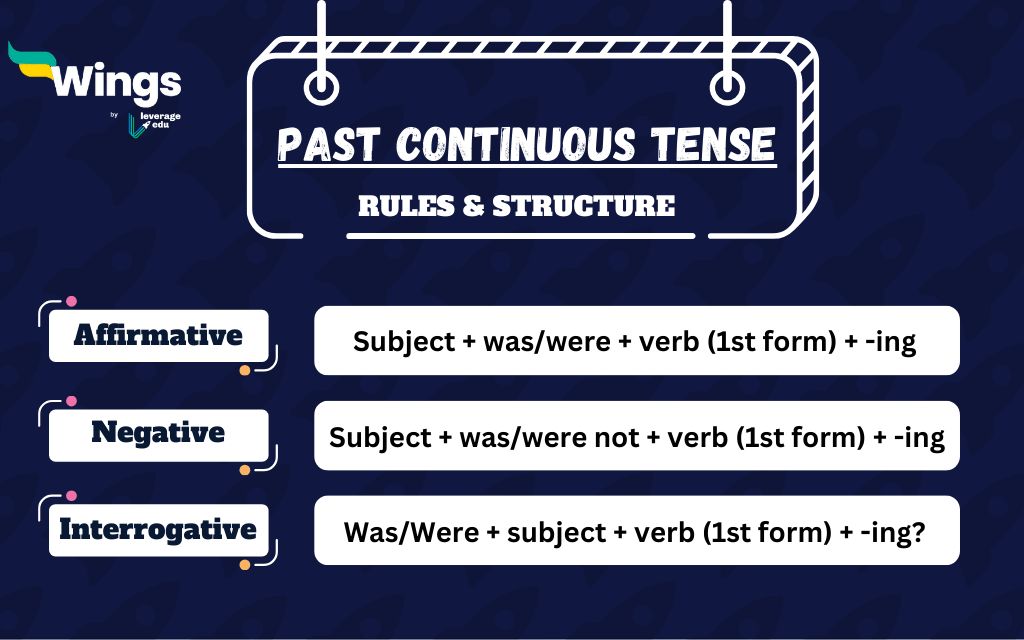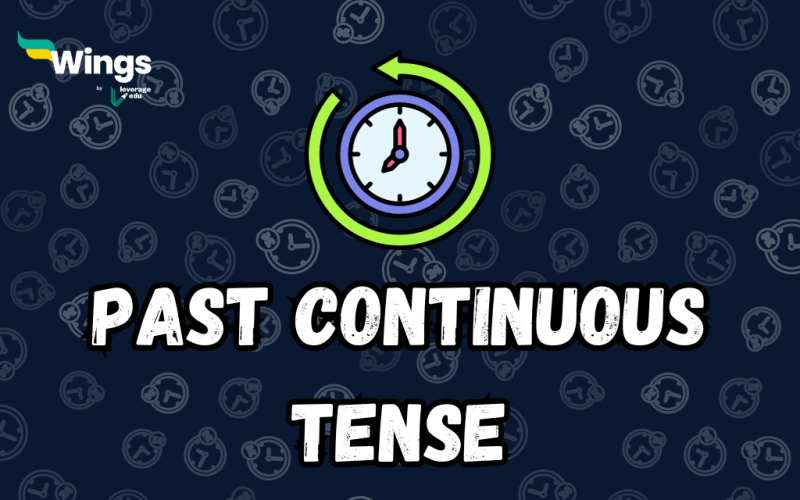Tenses are a category in the English Language to communicate according to the time reference. There are different parts of tenses and past continuous tenses examples in the blog article below are a part of the category. The past continuous tense is used to describe actions or events that were ongoing or in progress in the past at a specific time or to provide background information in a past narrative. Read the detailed information with past continuous tense examples and other important rules in the blog article below.
This Blog Includes:
- What is Past Continuous Tense?
- Structure of Past Continuous Tense
- Rules And Points to Remember When Using Past Continuous Tense
- How to Make Past Continuous Negative
- How to Make Past Continuous Positive
- Common Regular Verbs in Past Continuous Tense Examples
- Common Irregular Verbs in Past Continuous Tense Examples
- Past Continuous Tense Verb Tenses Sample Exercises
What is Past Continuous Tense?
The past tense continuous refers to actions or events that were happening at a particular time/moment in the past. To make you understand better, read the past continuous tense example:
She was eating with her best colleagues. Here, ‘was eating; is being referred to as an action that she was doing in the past.
Structure of Past Continuous Tense

Rules And Points to Remember When Using Past Continuous Tense
Knowing when and where to use the rules while using the past continuous tense will make an easy task for you. The rules will help you understand in a better way. Here are some rules and points to remember when using the past continuous tense:
- Structure:
- For affirmative statements: Subject + was/were + verb (1st form) + -ing.
- For negative statements: Subject + was/were not + verb (1st form) + -ing.
- For questions: Was/Were + subject + verb (1st form) + -ing?
- Use “was” for singular subjects (I, he, she, it) and “were” for plural subjects (we, you, they).
- Affirmative: I was studying. They were playing.
- Negative: She wasn’t listening. We weren’t sleeping.
- Interrogative: Were you working? Was he reading?
- Actions in progress: The past continuously describes actions or events that were happening at a specific time in the past.
- He was studying at 9 PM yesterday.
- They were playing football when it started raining.
- Background information: It is often used to provide context or background information in a narrative. It sets the scene for the main action.
- It was a beautiful day. The birds were singing, and the sun was shining.
- When I entered the room, she was reading a book.
- Parallel actions: You can use the past continuous tense to describe two or more actions that were happening simultaneously in the past.
- While I was cooking dinner, he was watching TV.
- They were talking and laughing at the party.
- Duration: The past continuous tense can convey the idea of the duration of an action in the past.
- I was working on the project for three hours yesterday.
- She was dancing all night at the party.
- Time expressions: Use time expressions to specify when the action took place.
- Last night, at 8 PM, during the meeting, while I was driving, etc.
- Stative verbs: Be cautious when using stative verbs (verbs that describe a state or condition) in the past continuous. Some stative verbs are not typically used in the continuous form.
- Incorrect: He believed in the concept.
- Correct: He believed in the concept.
- Use with “when” and “while”: The past continuous is often used with “when” to indicate two actions happening at the same time in the past.
- I was studying when she called.
- Negation and questions: Use “not” to make negative statements, and invert the subject and auxiliary verb for questions.
- Negative: I wasn’t eating at that time.
- Question: Were you sleeping when the phone rang?
- Contractions: In informal speech and writing, you can use contractions like “wasn’t” (for “was not”) and “weren’t” (for “were not”).
- Context: Ensure that the use of the past continuous makes sense in the context of your sentence or narrative.
Do Check Out: Leverage Edu Learn English Youtube Channel
Past Continuous Tense Exceptions
While the past continuous tense is generally straightforward to use, there are a few exceptions and special cases to be aware of:
- Stative Verbs: Some verbs that describe states rather than actions are not typically used in the continuous form, even in the past. These include verbs like “believe,” “know,” “love,” “hate,” “understand,” and “like.” For these verbs, you’d typically use the simple past tense. For example,
- Incorrect: She was knowing the answer.
- Correct: She knew the answer.
- Verbs of Perception: Verbs of perception like “see,” “hear,” “smell,” “taste,” and “feel” are often used in the simple form to describe momentary actions, while the continuous form is used to emphasize the ongoing nature of the perception. For example,
- Simple Past: I saw her at the party.
- Past Continuous: I was seeing a movie when the phone rang.
- Mixed Tenses: In complex sentences or narratives, you might find mixed tenses. This means that while the main action is in the past continuous, other actions or events are described in different past tenses to convey the sequence of events. Example: While she was studying, he cooked dinner and then watched TV.
- Non-Continuous Verbs: Some verbs are not used in continuous tenses because they represent abstract concepts or are considered non-physical actions. These include verbs like “believe,” “imagine,” “want,” “need,” and “mean. Example: “I wanted to go to the concert. (Not: I was wanting…)
- Future in the Past: Sometimes, the past continuous tense is used to talk about future actions from a past perspective. For example, “He was leaving for Paris tomorrow.”
- Expressing Politeness: In some cases, the past continuous can be used to express politeness when making a request or offering something. For example, “I was wondering if you could help me.”
These exceptions and special cases highlight the flexibility of English tenses and how they can be adapted to convey specific meanings and nuances. Understanding when to use the past continuous and when to use the simple past, and recognizing these exceptions, will help you use the tense correctly in different situations.
How to Make Past Continuous Negative
To make the past continuous tense negative in English, you need to use the auxiliary verb “was not” (for singular subjects like “I,” “he,” “she,” or “it”) or “were not” (for plural subjects like “we,” “you,” “they”) and then add the base form of the main verb with the -ing suffix. Here’s the basic structure:
For singular subjects: Subject + was not + (base form of the main verb + -ing)
For plural subjects: Subject + were not + (base form of the main verb + -ing)
Here are some examples:
- I was not eating dinner when you called.
- They were not studying for the test all evening.
In informal spoken English, you can also use contractions, such as “wasn’t” (for “was not”) and “weren’t” (for “were not”):
We weren’t playing basketball at that time.
I wasn’t eating dinner when you called.
How to Make Past Continuous Positive
To form the past continuous tense in a positive sentence, you use the past tense of the verb “to be” (either “was” for singular subjects or “were” for plural subjects) and then add the base form of the main verb with the -ing suffix. Here’s the basic structure:
For singular subjects: Subject + was + (base form of the main verb + -ing)
For plural subjects: Subject + were + (base form of the main verb + -ing)
Here are some examples:
- I was eating dinner when you called
- We were playing basketball at that time.
In informal spoken English, contractions can be used, such as “I was” becoming “I was,” and “they were” becoming “they were.”
I was eating dinner when you called.
They were studying for the test all evening.
Common Regular Verbs in Past Continuous Tense Examples
What are common regular verbs? Typically speaking, regular verbs in the past continuous tense are formed by adding the -ing ending to the base form of the verb and using the appropriate form of the auxiliary verb “was” for singular subjects (I, he, she, it) and “were” for plural subjects (we, you, they).
The table given below will help you understand the regular verbs in past continuous tense examples:
| Regular Verbs | Examples |
| Work | I was working on the project all night. |
| Play | They were playing soccer in the park. |
| Cook | He was cooking dinner when I called. |
| Talk | We were talking on the phone for hours. |
| Dance | The couple was dancing at the party. |
| Sing | She was singing a beautiful song. |
Common Irregular Verbs in Past Continuous Tense Examples
Irregular verbs do not follow the standard pattern of adding “-ing” to the base form of the verb to create the past continuous tense. Instead, they have unique past continuous forms. Here are some common irregular verbs in the past continuous tense examples:
| Irregular Verbs | Examples |
| Be (am/was, are/were) | I was talking to her on the phone.They were watching a movie at that time. |
| Have (had) | I had dinner with my family last night. |
| Go (went) | They went for a walk in the night. |
| See (saw) | I saw a shooting star last night. |
| Eat (ate) | I ate dinner when the phone rang. |
Past Continuous Tense Verb Tenses Sample Exercises
Here are some exercises for past continuous tenses:
Rewrite the following sentences in the past continuous tense
- I was watching a movie last night.
- She eats breakfast every morning.
- He reads a book in the evening.
- They go to the park on weekends.
- I write in my journal every day.
Answers:
- He was watching a movie last night.
- She was eating breakfast every morning.
- They were going to the park on weekends.
- I was writing in my journal every day.
Past Continuous Tense Verb Tenses Sample Exercises PDF
Related Posts
This was all about past continuous tense. Check out our Learn English page to improve your grammatical skills and read other informative blogs, and don’t forget to follow Leverage Edu.
 One app for all your study abroad needs
One app for all your study abroad needs














 25,000+ students realised their study abroad dream with us. Take the first step today.
25,000+ students realised their study abroad dream with us. Take the first step today.
